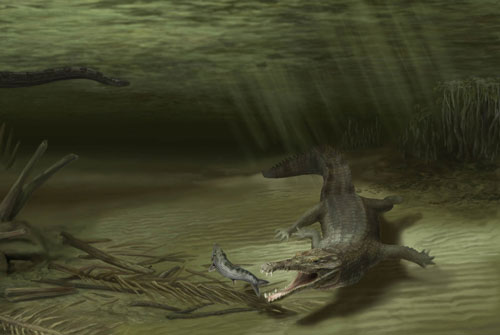Both reptiles occupied oldest known rainforest ecosystem
Researchers from the University of Florida have unearthed a previously-unknown massive crocodile measuring 20ft (6m) overall, which lived alongside Titanoboa, th
e world's largest snake. The findings help scientists better understand the diversity of animals that occupied the oldest known rainforest ecosystem, which had higher temperat
ures than today, and so could be useful for understanding the impacts of a warmer climate in the future on this type of habitat.

Illustration by Danielle Byerley, Florida Museum of Natural History.
How Acherontisuchus guajiraensis would have looked in its natural setting, about 60 million years ago. Titanoboa, the world's lar
gest snake, found in the same area, is pictured in the background.
Competing for prey
The 60-million-year-old freshwater relative of modern crocodiles is the first-known land animal from the Paleocene New World tropical region which was specialized for eat
ing fish, meaning it competed with Titanoboa for food. But the giant snake could have consumed its competition too, according to scientists.
"The younger crocodiles were definitely not safe from Titanoboa, but the biggest of these species would have been a bit much for the 42-foot snake to handle
," said lead author Alex Hastings, a graduate student at the Florida Museum of Natural History and UF's department of geological sciences.
The new species is a dyrosaurid, commonly believed to belong to a group of primarily ocean-dwelling, coastal reptiles. The location of these adult specimens challenge pre
vious theories that such crocodilians would only have entered freshwater environments as babies and then returned to sea.
Fossils of a partial skeleton of the species, now called Acherontisuchus guajiraensis, show dyrosaurids were key players in northeastern Colombia and that divers
ity within the family evolved with environmental changes, such as an asteroid impact or the appearance of competitors from other groups, said Christopher Brochu, an associate prof
essor of vertebrate paleontology in the department of geoscience at the University of Iowa, who was not involved in the study.
This new species is the second ancient crocodyliform found in the Cerrejon mine of northern Colombia, one of the world's largest open-pit coal mines. The excavations
were led by study co-authors Jonathan Bloch, Florida Museum associate curator of vertebrate paleontology, and paleobotanist Carlos Jaramillo of the Smithsonian Tropical Research I
nstitute.
Long-snouted specialists
"This one is related to a group that typically had these long snouts" Hastings said. "It would have had a relatively similar diet to the other
coastal species, but surprisingly, it lived in a more freshwater environment."
The genus is named for the river Acheron – "the river of woe" from Greek mythology – since this reptile occurred in a wide river that emptied into the
Caribbean. Unlike its relative previously found in the area, which had a more generalized diet, the snout of this new crocodile was long, narrow and full of pointed teeth, display
ing a specialization for hunting the lungfish and relatives of bonefish that inhabited these waters.
"The general common wisdom was that ancestrally, all crocodyliforms looked like a modern alligator, that all of these strange forms descended from a more general
ized ancestor, but these guys are showing that sometimes, one kind of specialized animal evolved from a very different specialized animal, not a generalized one," Brochu
said. "It's really showing us a level of complexity in their development that 10 years ago was not even anticipated."
In South America during the Paleocene, the environment was dominated by reptiles, including giant snakes, turtles and crocodiles. The dyrosaurid family originated in Afri
ca about 75 million years ago, toward the end of the age of dinosaurs, and is assumed to have arrived in South America by swimming across the Atlantic Ocean.
"The same thing that snuffed out the dinosaurs killed off most of the crocodiles alive at the time," Hastings said. "The dyrosaurids are one o
f the few groups to survive the period of mass extinction, however, and later become more successful."
Reference: Alexander K. Hastings, Jonathan I. Bloch, Carlos A. Jaramillo. A New Longirostrine Dyrosaurid (Crocodylomorpha, Mesoeucrocodylia) from the Paleocene of North-E
astern Colombia: Biogeographic and Behavioural Implications for New-World Dyrosauridae. Palaeontology,, 2011; 54 (5): 1095-1116 DOI: 10.1111/j.1475-4983.2011.01092.x


